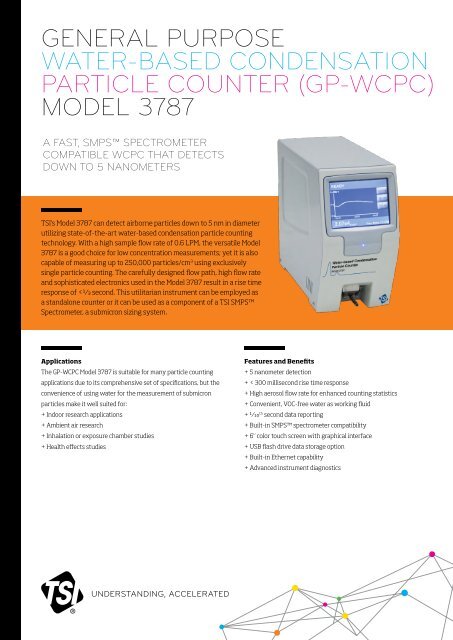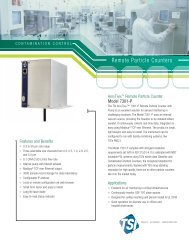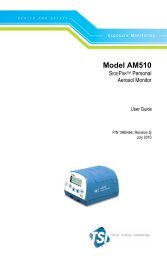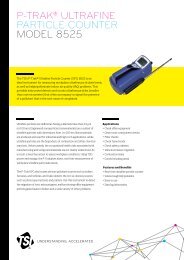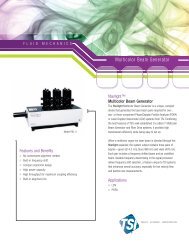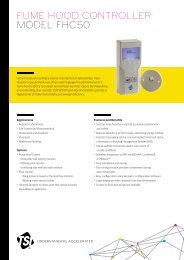model 3787 - Tsi
model 3787 - Tsi
model 3787 - Tsi
Create successful ePaper yourself
Turn your PDF publications into a flip-book with our unique Google optimized e-Paper software.
GENERAL PURPOSE<br />
WATER-BASED CONDENSATION<br />
PARTICLE COUNTER (GP-WCPC)<br />
MODEL <strong>3787</strong><br />
A FAST, SMPS SPECTROMETER<br />
COMPATIBLE WCPC THAT DETECTS<br />
DOWN TO 5 NANOMETERS<br />
TSI’s Model <strong>3787</strong> can detect airborne particles down to 5 nm in diameter<br />
utilizing state-of-the-art water-based condensation particle counting<br />
technology. With a high sample flow rate of 0.6 LPM, the versatile Model<br />
<strong>3787</strong> is a good choice for low concentration measurements; yet it is also<br />
capable of measuring up to 250,000 particles/cm 3 using exclusively<br />
single particle counting. The carefully designed flow path, high flow rate<br />
and sophisticated electronics used in the Model <strong>3787</strong> result in a rise time<br />
response of
P<br />
∆P<br />
Optical<br />
Particle<br />
Detector<br />
Heated<br />
Growth Tube<br />
Pressure<br />
Across<br />
Nozzle<br />
Cooled<br />
Conditioner<br />
Aerosol<br />
Flow<br />
0.6 LPM<br />
Inlet<br />
Pressure<br />
Sample Inlet<br />
0.6 or 1.5 LPM<br />
Porous<br />
Media<br />
Total Flow<br />
Filter<br />
to Water<br />
Drain<br />
Fill<br />
Bottle<br />
Total Flow Critical<br />
Orice 0.6LPM<br />
Internal Vaccum<br />
Water<br />
Separator<br />
Drain<br />
Pump<br />
Transport<br />
Flow Valve<br />
Pump<br />
Exhaust<br />
Transport Flow<br />
Critical Orice<br />
0 or 0.9LPM<br />
Transport<br />
Flow Filter<br />
*US Patent Number 6,712,881<br />
Second Generation WCPC Technology<br />
Building from the successful introductory line of WCPCs, the Model<br />
<strong>3787</strong> takes WCPC design to the next level by combining precision<br />
measurements with robust field performance. This instrument<br />
delivers a research quality measurement, but it’s modern, intuitive<br />
user interface and flexible data acquisition options make the<br />
GP-WCPC suitable for a variety of industrial applications as well.<br />
Newly engineered from the ground up, the Model <strong>3787</strong> features<br />
an air flow scheme utilizing protected critical orifices, a new<br />
water handling system with optimized wicking and active water<br />
removal, and improved optical and detection design for superior<br />
signal detection. A host of on-board instrument diagnostics<br />
including a laser reference detector, nozzle pressure transducer<br />
and inlet pressure transducer allow remote, real-time monitoring<br />
of instrument status. Other unique features include a removable<br />
wick cartridge for easy wick replacement and a field swappable<br />
optics module. Manufactured at TSI’s ISO 9001 certified facility and<br />
checked out and calibrated using NIST traceable analytical tools,<br />
each Model <strong>3787</strong> that leaves the factory is built for longevity,<br />
backed by TSI’s commitment to quality, and supported by our<br />
worldwide network of committed TSI professionals.<br />
Operation<br />
The GP-WCPC utilizes a patented* laminar-flow, water-based<br />
condensational growth technique. Laminar flow CPCs have less<br />
particle loss and more precise temperature control (resulting in<br />
more predictable particle growth) than mixing type CPCs. In CPCs,<br />
particles that are too small to scatter enough light to be detected<br />
by conventional optics are grown to a larger size by condensation.<br />
In this instrument, an air sample is continuously drawn through<br />
the inlet via an internal pump.<br />
+ Condition: The aerosol sample is pulled through a cool<br />
region saturated with water vapor where its temperature<br />
is equilibrated.<br />
+ Grow: The sample then passes to a growth section where wetted<br />
walls are heated to produce an elevated vapor pressure resulting<br />
in a thermodynamic ‘supersaturation’ condition. The small cool<br />
particles in the flow stream act as nuclei for condensation and<br />
grow into micron sized droplets.<br />
+ Detect: The droplets are passed by a laser and create a large light<br />
pulse. Particle pulses are detected and counted. The GP-WCPC<br />
counts single particles with continuous, livetime coincidence<br />
correction to provide accurate concentration measurements up<br />
to 250,000 particles/cm3 .
Software and SMPS Spectrometer Compatibility<br />
The GP-WCPC comes with built-in compatibility for use in TSI<br />
SMPS spectrometers, which when operated together, are capable<br />
of providing size distributions from 0.005 to 1 μm. The Model<br />
<strong>3787</strong> is supplied with Aerosol Instrument Manager® software for<br />
CPCs which features comprehensive statistical analysis, advanced<br />
instrument diagnostics, real-time data display, advanced file<br />
management, easy data export options, and auto recovery from<br />
power failure.<br />
Pulse Height Analyzer<br />
The GP-WCPC utilizes a pulse height analyzer to monitor instrument<br />
health and supersaturation state as a safeguard for measurement<br />
accuracy. In well functioning CPCs the particles all grow to a similar<br />
size and the analog pulses all have a similar height. The Model <strong>3787</strong><br />
monitors and displays the amplitude of the analog pulse height on<br />
the status screen of the instrument. A warning will trigger if the<br />
pulse height amplitude falls below a threshold value.<br />
GP-WCPC Response Time<br />
The response of the GP-WCPC to a step change in concentration<br />
was measured and is plotted below. The ~750 millisecond time to<br />
a 95% response in concentration in high flow mode includes a flow<br />
rate based pipe delay. Under normal operation with constant flow,<br />
the traditional rise time (10-90%) is < 300 milliseconds. The time<br />
constant (t) of the Model <strong>3787</strong> is ~130 milliseconds.<br />
Response (%)<br />
110%<br />
100%<br />
90%<br />
80%<br />
70%<br />
60%<br />
50%<br />
40%<br />
30%<br />
20%<br />
10%<br />
0%<br />
GP-WCPC Model <strong>3787</strong> Response Time<br />
0.6 LPM -<br />
0.6 LPM +<br />
1.5 LPM -<br />
1.5 LPM +<br />
0 0.2 0.4 0.6 0.8 1 1.2 1.4 1.6 1.8 2<br />
Time (sec)<br />
Extended Single Particle Counting<br />
The Model <strong>3787</strong> employs optimized optics design, more controlled<br />
particle growth and advanced electronics processing to extend the<br />
single particle counting range of condensation particle counters.<br />
Single particle counting gives greater data consistency and is in<br />
principle, a more fundamental measurement than other techniques<br />
used to increase concentration ranges in CPCs.<br />
Efficiency and Concentration Linearity<br />
The minimum size particle detection efficiency was determined<br />
using sucrose aerosol generated by a Electrospray Model 3480<br />
and size classified using the Electrostatic Classifier Model 3080.<br />
GP-WCPC concentration comparisons were made versus both<br />
a butanol CPC with a dilution bridge and an electrometer using<br />
classified salt aerosol showing excellent agreement.<br />
Concentration <strong>3787</strong> (particles/cm3 Concentration <strong>3787</strong> (particles/cm )<br />
Counting Eciency %<br />
GP-WCPC Model <strong>3787</strong> Concenteration Linearity<br />
vs. Butanol CPC w/Dilution Bridge<br />
1.0E+06<br />
1.0E+05<br />
1.0E+04<br />
y = 1.0001x<br />
R2 = 0.9973<br />
GP-WCPC Model <strong>3787</strong><br />
1.0E+03<br />
1.0E+03 1.0E+04 1.0E+05 1.0E+06<br />
110%<br />
100%<br />
90%<br />
80%<br />
70%<br />
60%<br />
50%<br />
40%<br />
30%<br />
20%<br />
10%<br />
0%<br />
1<br />
Concentration 3010 w/Dilution Bridge (particles/cm 3 )<br />
GP-WCPC Model <strong>3787</strong> Eciency (Sucrose)<br />
10<br />
Particle Size (nm)<br />
100
SPECIFICATIONS<br />
GENERAL PURPOSE WATER-BASED CONDENSATION PARTICLE COUNTER (GP-WCPC)<br />
MODEL <strong>3787</strong><br />
Particle Size Range<br />
Min. Detectable Particle (D 50) 5 nm, verified with DMA-classified sucrose<br />
Max. Detectable Particle > 3 µm<br />
Particle Concentration Range<br />
Single Particle Counting 0 to 250,000 particles/cm 3 , with continuous<br />
live-time coincidence correction<br />
Particle Concentration Accuracy<br />
±10% at 250,000 particles/cm 3<br />
Flow<br />
High Flow Rate 1.5 ±0.15 L/min<br />
Low Inlet Flow Rate 0.6 ±0.06 L/min<br />
Aerosol Flow Rate 0.6 ±0.06 L/min<br />
Response Time (95% Response to Concentration Step Change)<br />
High Flow (1.5 LPM) ~ ¾ second<br />
Low Flow (0.6 LPM) ~ 1 second<br />
Rise Time (10-90%) < 300 milliseconds<br />
Time Constant (t) ~ 130 milliseconds<br />
False Background Counts<br />


